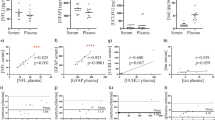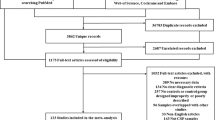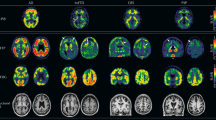Abstract
Patients with parkinsonian symptoms can present either to primary care physicians or to neurologists. In both contexts, differential diagnosis is problematic, particularly early in the disease when only subtle bradykinesia, rigidity or tremor is present. Adjunctive tests should help substantially to improve the accuracy of early clinical diagnosis. This Review appraises cerebrospinal fluid (CSF), plasma and urine biomarkers that have been studied in the differential diagnosis of neurodegenerative parkinsonism. CSF biomarkers seem to hold the most promise because of their intimacy with the degenerating neurons. Most assays are still in the early stages of development, but CSF measures of α-synuclein (specific for Parkinson disease) and tau fragments (specific for progressive supranuclear palsy) have been refined. Universal approval of these assays will depend on larger clinical trials and establishment of normal ranges. Other blood and CSF biomarkers have shown exceptional specificity and sensitivity when analyzed in combination, although these findings require verification. A host of potential biomarkers have, however, produced disappointing results, either because of poor specificity or low assay reproducibility. Despite such difficulties, improved technology, in conjunction with advances in nosology and pathology, means that biomarkers are poised to enter routine clinical practice to aid the differentiation of parkinsonian disorders.
Key Points
-
Clinical differentiation between parkinsonian disorders can be difficult, if not impossible, in the early disease stages
-
Adjunctive biological markers with high specificity would aid early diagnosis
-
Many biomarkers to date have suffered from poor reproducibility and low specificity
-
Measurements of α-synuclein and tau forms in cerebrospinal fluid seem to be the most promising assays when used in the appropriate clinical context (Parkinson disease versus progressive supranuclear palsy)
-
Diagnostic accuracy might be further improved by combining these assays with other biomarker modalities
This is a preview of subscription content, access via your institution
Access options
Subscribe to this journal
Receive 12 print issues and online access
$209.00 per year
only $17.42 per issue
Buy this article
- Purchase on Springer Link
- Instant access to full article PDF
Prices may be subject to local taxes which are calculated during checkout


Similar content being viewed by others
References
de Rijk, M. C. et al. Prevalence of parkinsonism and Parkinson's disease in Europe: the EUROPARKINSON Collaborative Study. European Community Concerted Action on the Epidemiology of Parkinson's disease. J Neurol. Neurosurg. Psychiatry 62, 10–15 (1997).
Miller, D. C., Hafez, K. S., Stewart, A., Montie, J. E. & Wei, J. T. Prostate carcinoma presentation, diagnosis, and staging: an update form the National Cancer Data Base. Cancer 98, 1169–1178 (2003).
O'Sullivan, S. S. et al. Clinical outcomes of progressive supranuclear palsy and multiple system atrophy. Brain 131, 1362–1372 (2008).
Hughes, A. J., Daniel, S. E., Ben-Shlomo, Y. & Lees, A. J. The accuracy of diagnosis of parkinsonian syndromes in a specialist movement disorder service. Brain 125, 861–870 (2002).
Litvan, I. et al. Accuracy of the clinical diagnosis of corticobasal degeneration: a clinicopathologic study. Neurology 48, 119–125 (1997).
Osaki, Y. et al. Accuracy of clinical diagnosis of progressive supranuclear palsy. Mov. Disord. 19, 181–189 (2004).
Hughes, A. J., Daniel, S. E., Kilford, L. & Lees, A. J. Accuracy of clinical diagnosis of idiopathic Parkinson's disease: a clinico-pathological study of 100 cases. J. Neurol. Neurosurg. Psychiatry 55, 181–184 (1992).
Osaki, Y. et al. Do published criteria improve clinical diagnostic accuracy in multiple system atrophy? Neurology 59, 1486–1491 (2002).
Rajput, A. H., Rozdilsky, B. & Rajput, A. Accuracy of clinical diagnosis in parkinsonism—a prospective study. Can. J. Neurol. Sci. 18, 275–278 (1991).
Schrag, A., Ben-Shlomo, Y. & Quinn, N. How valid is the clinical diagnosis of Parkinson's disease in the community? J. Neurol. Neurosurg. Psychiatry 73, 529–534 (2002).
Katzenschlager, R., Cardozo, A., Avila Cobo, M. R., Tolosa, E. & Lees, A. J. Unclassifiable parkinsonism in two European tertiary referral centres for movement disorders. Mov. Disord. 18, 1123–1131 (2003).
Spillantini, M. G. et al. α-Synuclein in Lewy bodies. Nature 388, 839–840 (1997).
Lewy, F. H. Paralysis agitans. In Handbuch der Neurologie (Ed. Lawandowsky, M.) 920–958 (Springer-Verlag, Berlin, 1912).
Kosaka, K. Diffuse Lewy body disease in Japan. J. Neurol. 237, 197–204 (1990).
McKeith, I. G. et al. Consensus guidelines for the clinical and pathologic diagnosis of dementia with Lewy bodies (DLB): report of the consortium on DLB international workshop. Neurology 47, 1113–1124 (1996).
Polymeropoulos, M. H. et al. Mapping of a gene for Parkinson's disease to chromosome 4q21-q23. Science 274, 1197–1199 (1996).
Mollenhauer, B. et al. Direct quantification of CSF α-synuclein by ELISA and first cross-sectional study in patients with neurodegeneration. Exp. Neurol. 213, 315–325 (2008).
Tokuda, T. et al. Decreased α-synuclein in cerebrospinal fluid of aged individuals and subjects with Parkinson's disease. Biochem. Biophys. Res. Commun. 349, 162–166 (2006).
Barber, R., Panikkar, A. & McKeith, I. G. Dementia with Lewy bodies: diagnosis and management. Int. J. Geriatr. Psychiatry 16 (Suppl. 1), S12–S18 (2001).
Holmberg, B., Johnels, B., Blennow, K. & Rosengren, L. Cerebrospinal fluid Aβ42 is reduced in multiple system atrophy but normal in Parkinson's disease and progressive supranuclear palsy. Mov. Disord. 18, 186–190 (2003).
Kanemaru, K., Kameda, N. & Yamanouchi, H. Decreased CSF amyloid-β42 and normal tau levels in dementia with Lewy bodies. Neurology 54, 1875–1876 (2000).
Sjögren, M. et al. CSF levels of tau, β-amyloid1–42 and GAP-43 in frontotemporal dementia, other types of dementia and normal aging. J. Neural Transm. 107, 563–579 (2000).
Verbeek, M. M. et al. Cerebrospinal fluid Aβ42 levels in multiple system atrophy. Mov. Disord. 19, 238–240 (2004).
Mollenhauer, B. et al. β-amlyoid1–42 and tau-protein in cerebrospinal fluid of patients with Parkinson's disease dementia. Dement. Geriatr. Cogn. Disord. 22, 200–208 (2006).
Spillantini, M. G. & Goedert, M. Tau protein pathology in neurodegenerative diseases. Trends Neurosci. 21, 428–433 (1998).
Perl, D. P. Neuropathology of Alzheimer's disease and related disorders. Neurol. Clin. 18, 847–864 (2000).
Sonnen, J. A. et al. Biomarkers for cognitive impairment and dementia in elderly people. Lancet Neurol. 7, 704–714 (2008).
Dubois, B. et al. Research criteria for the diagnosis of Alzheimer's disease: revising the NINCDS–ADRDA criteria. Lancet Neurol. 6, 734–746 (2007).
Clark, L. N. et al. Mutations in the glucocerebrosidase gene are associated with early-onset Parkinson disease. Neurology 69, 1270–1277 (2007).
Balducci, C. et al. Lysosomal hydrolases in cerebrospinal fluid from subjects with Parkinson's disease. Mov. Disord. 22, 1481–1484 (2007).
Zhang, J. et al. CSF multianalyte profile distinguishes Alzheimer and Parkinson diseases. Am. J. Clin. Pathol. 129, 526–529 (2008).
Litvan, I. et al. Accuracy of clinical criteria for the diagnosis of progressive supranuclear palsy (Steele–Richardson–Olszewski syndrome). Neurology 46, 922–930 (1996).
Steele, J. C., Richardson, J. C. & Olszewski, J. Progressive supranuclear palsy. A heterogeneous degeneration involving the brain stem, basal ganglia and cerebellum with vertical gaze and pseudobulbar palsy, nuchal dystonia and dementia. Arch. Neurol. 10, 333–359 (1964).
Williams, D. R. et al. Characteristics of two distinct clinical phenotypes in pathologically proven progressive supranuclear palsy: Richardson's syndrome and PSP-parkinsonism. Brain 128, 1247–1258 (2005).
Williams, D. R. et al. Pathological tau burden and distribution distinguishes progressive supranuclear palsy-parkinsonism from Richardson's syndrome. Brain 130, 1566–1576 (2007).
Jellinger, K. A., Bancher, C., Hauw, J. J. & Verny, M. Progressive supranuclear palsy: neuropathologically based diagnostic clinical criteria. J. Neurol. Neurosurg. Psychiatry 59, 106 (1995).
Noguchi, M. et al. Decreased β-amyloid peptide42 in cerebrospinal fluid of patients with progressive supranuclear palsy and corticobasal degeneration. J. Neurol. Sci. 237, 61–65 (2005).
Borroni, B. et al. Pattern of tau forms in CSF is altered in progressive supranuclear palsy. Neurobiol. Aging 30, 34–40 (2009).
Borroni, B. et al. Tau forms in CSF as a reliable biomarker for progressive supranuclear palsy. Neurology 71, 1796–1803 (2008).
Gai, W. P., Power, J. H., Blumbergs, P. C. & Blessing, W. W. Multiple-system atrophy: a new α-synuclein disease? Lancet 352, 547–548 (1998).
Petzold, A. Neurofilament phosphoforms: surrogate markers for axonal injury, degeneration and loss. J. Neurol. Sci. 233, 183–198 (2005).
Holmberg, B., Rosengren, L., Karlsson, J. E. & Johnels, B. Increased cerebrospinal fluid levels of neurofilament protein in progressive supranuclear palsy and multiple-system atrophy compared with Parkinson's disease. Mov. Disord. 13, 70–77 (1998).
Brettschneider, J. et al. Neurofilament heavy-chain NfHSMI35 in cerebrospinal fluid supports the differential diagnosis of Parkinsonian syndromes. Mov. Disord. 21, 2224–2227 (2006).
Sanchez-Juan, P. et al. CSF tests in the differential diagnosis of Creutzfeldt–Jakob disease. Neurology 67, 637–643 (2006).
Otto, M. et al. Elevated levels of tau-protein in cerebrospinal fluid of patients with Creutzfeldt–Jakob disease. Neurosci. Lett. 225, 210–212 (1997).
Rebeiz, J. J., Kolodny, E. H. & Richardson, E. P., Jr. Corticodentatonigral degeneration with neuronal achromasia. Arch. Neurol. 18, 20–33 (1968).
Boeve, B. F. et al. Pathologic heterogeneity in clinically diagnosed corticobasal degeneration. Neurology 53, 795–800 (1999).
Hodges, J. R. et al. Clinicopathological correlates in frontotemporal dementia. Ann. Neurol. 56, 399–406 (2004).
Urakami, K. et al. Diagnostic significance of tau protein in cerebrospinal fluid from patients with corticobasal degeneration or progressive supranuclear palsy. J. Neurol. Sci. 183, 95–98 (2001).
Bian, H. et al. CSF biomarkers in frontotemporal lobar degeneration with known pathology. Neurology 70, 1827–1835 (2008).
Riemenschneider, M. et al. Tau and Aβ42 protein in CSF of patients with frontotemporal degeneration. Neurology 58, 1622–1628 (2002).
Pijnenburg, Y. A. et al. CSF biomarkers in frontotemporal lobar degeneration: relations with clinical characteristics, apolipoprotein E genotype, and neuroimaging. J. Neurol. Neurosurg. Psychiatry 77, 246–248 (2006).
Schoonenboom, N. S. et al. Amyloid β(1–42) and phosphorylated tau in CSF as markers for early-onset Alzheimer disease. Neurology 62, 1580–1584 (2004).
Fabre, S. F. et al. Clinic-based cases with frontotemporal dementia show increased cerebrospinal fluid tau and high apolipoprotein E ε4 frequency, but no tau gene mutations. Exp. Neurol. 168, 413–418 (2001).
Green, A. J., Harvey, R. J., Thompson, E. J. & Rossor, M. N. Increased tau in the cerebrospinal fluid of patients with frontotemporal dementia and Alzheimer's disease. Neurosci. Lett. 259, 133–135 (1999).
Mehta, P. D. et al. Plasma and cerebrospinal fluid levels of amyloid β proteins 1–40 and 1–42 in Alzheimer disease. Arch. Neurol. 57, 100–105 (2000).
Pijnenburg, Y. A. et al. Decreased cerebrospinal fluid amyloid β(1–40) levels in frontotemporal lobar degeneration. J. Neurol. Neurosurg. Psychiatry 78, 735–737 (2007).
de Jong, D. et al. CSF neurofilament proteins in the differential diagnosis of dementia. J. Neurol. Neurosurg. Psychiatry 78, 936–938 (2007).
Zijlmans, J. C., Daniel, S. E., Hughes, A. J., Revesz, T. & Lees, A. J. Clinicopathological investigation of vascular parkinsonism, including clinical criteria for diagnosis. Mov. Disord. 19, 630–640 (2004).
Andreasen, N. et al. Sensitivity, specificity, and stability of CSF-tau in AD in a community-based patient sample. Neurology 53, 1488–1494 (1999).
Vigo-Pelfrey, C. et al. Elevation of microtubule-associated protein tau in the cerebrospinal fluid of patients with Alzheimer's disease. Neurology 45, 788–793 (1995).
de Jong, D., Jansen, R. W., Kremer, B. P. & Verbeek, M. M. Cerebrospinal fluid amyloid β42/phosphorylated tau ratio discriminates between Alzheimer's disease and vascular dementia. J. Gerontol. A. Biol. Sci. Med. Sci. 61, 755–758 (2006).
Kosunen, O. et al. Diagnostic accuracy of Alzheimer's disease: a neuropathological study. Acta Neuropathol. 91, 185–193 (1996).
Hakim, S. & Adams, R. D. The special clinical problem of symptomatic hydrocephalus with normal cerebrospinal fluid pressure. Observations on cerebrospinal fluid hydrodynamics. J. Neurol. Sci. 2, 307–327 (1965).
Schott, J. M. et al. Shunt responsive progressive supranuclear palsy? Mov. Disord. 22, 902–903 (2007).
Savolainen, S., Paljarvi, L. & Vapalahti, M. Prevalence of Alzheimer's disease in patients investigated for presumed normal pressure hydrocephalus: a clinical and neuropathological study. Acta Neurochir. (Wien) 141, 849–853 (1999).
Kudo, T. et al. Tau protein is a potential biological marker for normal pressure hydrocephalus. Psychiatry Clin. Neurosci. 54, 199–202 (2000).
Kapaki, E. N. et al. Cerebrospinal fluid tau, phospho-tau181 and β-amyloid1–42 in idiopathic normal pressure hydrocephalus: a discrimination from Alzheimer's disease. Eur. J. Neurol. 14, 168–173 (2007).
Bateman, R. J., Wen, G., Morris, J. C. & Holtzman, D. M. Fluctuations of CSF amyloid-β levels: implications for a diagnostic and therapeutic biomarker. Neurology 68, 666–669 (2007).
Lewczuk, P. et al. International quality control survey of neurochemical dementia diagnostics. Neurosci. Lett. 409, 1–4 (2006).
Blennow, K. et al. Longitudinal stability of CSF biomarkers in Alzheimer's disease. Neurosci. Lett. 419, 18–22 (2007).
Kaiser, E., Schonknecht, P., Thomann, P. A., Hunt, A. & Schroder, J. Influence of delayed CSF storage on concentrations of phospho-tau protein (181), total tau protein and β-amyloid (1–42). Neurosci. Lett. 417, 193–195 (2007).
Lewczuk, P. et al. Effect of sample collection tubes on cerebrospinal fluid concentrations of tau proteins and amyloid β peptides. Clin. Chem. 52, 332–334 (2006).
Weisskopf, M. G., O'Reilly, E., Chen, H., Schwarzschild, M. A. & Ascherio, A. Plasma urate and risk of Parkinson's disease. Am. J. Epidemiol. 166, 561–567 (2007).
Davis, J. W. et al. Observations on serum uric acid levels and the risk of idiopathic Parkinson's disease. Am. J. Epidemiol. 144, 480–484 (1996).
de Lau, L. M., Koudstaal, P. J., Hofman, A. & Breteler, M. M. Serum uric acid levels and the risk of Parkinson disease. Ann. Neurol. 58, 797–800 (2005).
Alonso, A., Rodriguez, L. A., Logroscino, G. & Hernan, M. A. Gout and risk of Parkinson disease: a prospective study. Neurology 69, 1696–1700 (2007).
Duan, W. et al. Dietary folate deficiency and elevated homocysteine levels endanger dopaminergic neurons in models of Parkinson's disease. J. Neurochem. 80, 101–110 (2002).
Church, W. H. & Ward, V. L. Uric acid is reduced in the substantia nigra in Parkinson's disease: effect on dopamine oxidation. Brain Res. Bull. 33, 419–425 (1994).
Schwarzschild, M. A. et al. Serum urate as a predictor of clinical and radiographic progression in Parkinson disease. Arch. Neurol. 65, 716–723 (2008).
Bogdanov, M. et al. Metabolomic profiling to develop blood biomarkers for Parkinson's disease. Brain 131, 389–396 (2008).
Connolly, J., Siderowf, A., Clark, C. M., Mu, D. & Pratico, D. F2 isoprostane levels in plasma and urine do not support increased lipid peroxidation in cognitively impaired Parkinson disease patients. Cogn. Behav. Neurol. 21, 83–86 (2008).
Sato, S., Mizuno, Y. & Hattori, N. Urinary 8-hydroxydeoxyguanosine levels as a biomarker for progression of Parkinson disease. Neurology 64, 1081–1083 (2005).
Barbour, R. et al. Red blood cells are the major source of alpha-synuclein in blood. Neurodegener. Dis. 5, 55–59 (2008).
Michell, A. W., Luheshi, L. M. & Barker, R. A. Skin and platelet α-synuclein as peripheral biomarkers of Parkinson's disease. Neurosci. Lett. 381, 294–298 (2005).
Tamo, W. et al. Expression of α-synuclein, the precursor of non-amyloid β component of Alzheimer's disease amyloid, in human cerebral blood vessels. Neurosci. Lett. 326, 5–8 (2002).
Hoepken, H. H. et al. Parkinson patient fibroblasts show increased alpha-synuclein expression. Exp. Neurol. 212, 307–313 (2008).
Michell, A. W., Lewis, S. J., Foltynie, T. & Barker, R. A. Biomarkers and Parkinson's disease. Brain 127, 1693–1705 (2004).
Tolosa, E., Wenning, G. & Poewe, W. The diagnosis of Parkinson's disease. Lancet Neurol. 5, 75–86 (2006).
Gibb, W. R. & Lees, A. J. The relevance of the Lewy body to the pathogenesis of idiopathic Parkinson's disease. J. Neurol. Neurosurg. Psychiatry 51, 745–752 (1988).
Williams, D. R. & Lees, A. J. Progressive supranuclear palsy: clinicopathological concepts and diagnostic challenges. Lancet Neurol. 8, 270–279 (2009).
Litvan, I. et al. Clinical research criteria for the diagnosis of progressive supranuclear palsy (Steele–Richardson–Olszewski syndrome): report of the NINDS-SPSP international workshop. Neurology 47, 1–9 (1996).
Gilman, S. et al. Second consensus statement on the diagnosis of multiple system atrophy. Neurology 71, 670–676 (2008).
Acknowledgements
Dr. Michael Eller was funded through the Rasmussen Bequest. We would like to thank Tania McKenny for her assistance in the preparation of this manuscript.
Author information
Authors and Affiliations
Corresponding author
Ethics declarations
Competing interests
The authors declare no competing financial interests.
Rights and permissions
About this article
Cite this article
Eller, M., Williams, D. Biological fluid biomarkers in neurodegenerative parkinsonism. Nat Rev Neurol 5, 561–570 (2009). https://doi.org/10.1038/nrneurol.2009.135
Published:
Issue Date:
DOI: https://doi.org/10.1038/nrneurol.2009.135
This article is cited by
-
Diagnostic utility of fluid biomarkers in multiple system atrophy: a systematic review and meta-analysis
Journal of Neurology (2021)
-
Development of Early Diagnosis of Parkinson’s Disease Using Premotor Symptoms and Blood Changes as Biomarkers
Neuroscience and Behavioral Physiology (2021)
-
Metabolomic changes associated with frontotemporal lobar degeneration syndromes
Journal of Neurology (2020)
-
Upgraded Methodology for the Development of Early Diagnosis of Parkinson’s Disease Based on Searching Blood Markers in Patients and Experimental Models
Molecular Neurobiology (2019)
-
MPTP Mouse Model of Preclinical and Clinical Parkinson’s Disease as an Instrument for Translational Medicine
Molecular Neurobiology (2018)



